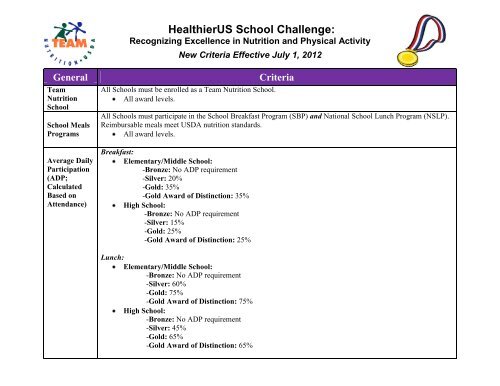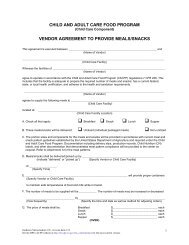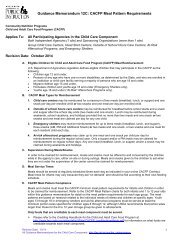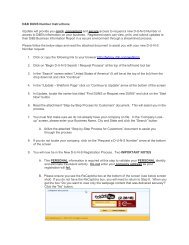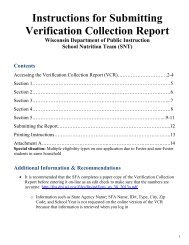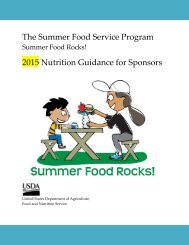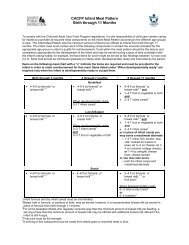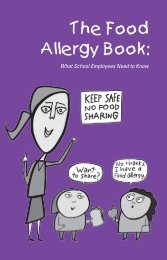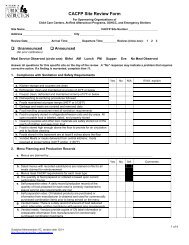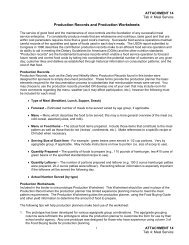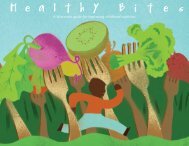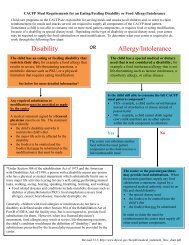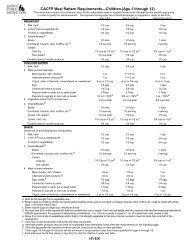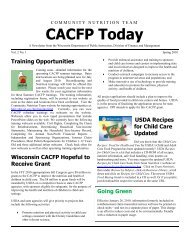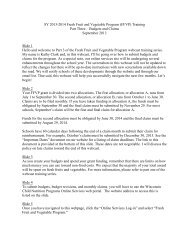Attachment: Revised HUSSC Criteria Chart - WI Child Nutrition ...
Attachment: Revised HUSSC Criteria Chart - WI Child Nutrition ...
Attachment: Revised HUSSC Criteria Chart - WI Child Nutrition ...
You also want an ePaper? Increase the reach of your titles
YUMPU automatically turns print PDFs into web optimized ePapers that Google loves.
HealthierUS School Challenge:Recognizing Excellence in <strong>Nutrition</strong> and Physical ActivityNew <strong>Criteria</strong> Effective July 1, 2012GeneralTeam<strong>Nutrition</strong>SchoolSchool MealsProgramsAverage DailyParticipation(ADP;CalculatedBased onAttendance)All Schools must be enrolled as a Team <strong>Nutrition</strong> School.All award levels.<strong>Criteria</strong>All Schools must participate in the School Breakfast Program (SBP) and National School Lunch Program (NSLP).Reimbursable meals meet USDA nutrition standards.All award levels.Breakfast:Elementary/Middle School:-Bronze: No ADP requirement-Silver: 20%-Gold: 35%-Gold Award of Distinction: 35%High School:-Bronze: No ADP requirement-Silver: 15%-Gold: 25%-Gold Award of Distinction: 25%Lunch:Elementary/Middle School:-Bronze: No ADP requirement-Silver: 60%-Gold: 75%-Gold Award of Distinction: 75%High School:-Bronze: No ADP requirement-Silver: 45%-Gold: 65%-Gold Award of Distinction: 65%
<strong>HUSSC</strong> 2012 <strong>Criteria</strong>/ 2BreakfastFruits andVegetablesBronze/Silver:<strong>Criteria</strong>At least three different fruit and vegetables must be offered each week.At least 1 fruit/week must be served fresh.Gold/Gold Award of Distinction:At least one different fruit and/or vegetable must be offered every day. At least 2 fruits/week must be served fresh.Bronze/Silver:Grains50% of grains offered weekly are whole grain-rich.*Gold:70% of grains offered weekly are whole grain-rich.*Gold Award of Distinction:100% of grains offered weekly are whole grain-rich.** The definition of whole grain-rich will be consistent with USDA policy guidance on new meal patternrequirements 7 CFR 210.10(c)(2)(iv).
<strong>HUSSC</strong> 2012 <strong>Criteria</strong>/ 3LunchVegetablesAll Award Levels:<strong>Criteria</strong>Dark green, red and orange, and dry beans and peas must be offered in amounts equivalent to the mealpattern.Bronze/Silver:Offer one additional serving weekly from any of three vegetable sub-groups (dark green, red and orange,dry beans and peas).Gold/Gold Award of Distinction:Offer two additional servings weekly from any of three vegetable sub-groups (dark green, red and orange,dry beans and peas).FruitsAll Award Levels:At least five different fruits must be offered each week (fresh, frozen, canned, dried, or 100% juice). Dried fruitmust have no added sweetener; canned fruit must be packed in juice or light syrup. 100% juice can be counted as afruit only once per week.Bronze:1 fruit/week must be served fresh.Silver:2 fruits/week must be served fresh.Gold:3 fruits/week must be served fresh.Gold Award of Distinction:4 fruits/week must be served fresh.
<strong>HUSSC</strong> 2012 <strong>Criteria</strong>/ 4LunchGrainsBronze/Silver:<strong>Criteria</strong>Two-thirds of the minimum required grains offered over a week must be whole grain-rich*, which equates to aminimum of 6, 7, and 8 servings required in grades K-5, 6-8 and 9-12, respectively. If there is an overlap of gradesin a school, it must offer the minimum servings required of the higher-grade group.Gold/Gold Award of Distinction:All grains offered must be whole grain-rich*.Whole Grain-Rich Variety:Bronze/Silver/Gold:At least three different types of whole grain-rich* foods offered during the week.Gold Award of Distinction:Same as Gold plus only one whole grain-rich* offering per week may be a grain-based dessert.* The definition of whole grain-rich will be consistent with USDA policy guidance on new meal patternrequirements 7 CFR 210.10(c)(2)(iv).
<strong>HUSSC</strong> 2012 <strong>Criteria</strong>/ 5<strong>Nutrition</strong>EducationAdditional <strong>Criteria</strong>Elementary School:For all award levels, nutrition education is provided in all grades.Middle School:Bronze/Silver: Offered in at least one grade during the school year.Gold/Gold Award of Distinction: Offered in at least 2 grades.High School:For all award levels, nutrition education offered in 2 courses required for graduation.PhysicalEducation(PE)Structured physical education must be provided:Elementary School:Gold Award of Distinction: minimum average 150* min/per week throughout the school year.Gold: minimum average of 90* min/week throughout the school year.Silver/Bronze: minimum average of 45* min/week throughout the school year.*Up to 20 minutes (Bronze/Silver) and 45 minutes (Gold/Gold Award of Distinction) of the PE requirement maybe met by providing structured physical activity planned by a certified PE teacher and implemented by a classroomteacher or school administrator. All students must participate in the physical activities, which must be at leastmoderate-intensity and in increments of at least 10 minutes.Middle School:For all award levels, structured physical education offered to at least 2 grades.High School:For all award levels, structured physical education offered in at least 2 courses.
<strong>HUSSC</strong> 2012 <strong>Criteria</strong>/ 8Other<strong>Criteria</strong> forExcellenceOptions (continued from page 7):School Food Service Excellence School Food Service Manager is a certified food handler (local or national certification) School has a Farm to School initiative. Smarter Lunchroom techniques are used to encourage fruit consumption: Fruit is displayed in 2 locations,one of which is near the cash register, on all lunch lines. Attractive displays, signage, and staffencouragement are used to draw attention to the fruit and encourage children to select them. Smarter Lunchroom techniques are used to encourage vegetable consumption: Students are given theopportunity to provide input into vegetable offerings and to identify creative/descriptive names for theofferings. Creative/descriptive names are displayed with vegetables on the lunch line as well as on a posteror menu board outside the school cafeteria. When offered, dark-green, red and orange vegetables and dry beans and peas are displayed first or mostprominently among vegetable side dishes on the lunch line. Smarter Lunchroom techniques are used to encourage consumption of dry beans and peas: Entrees thatinclude dry beans or peas are displayed first or most prominently on the lunch line amongst other entréeitems on at least 2 days within the 4-week menu cycle submitted. Dry bean and pea entrée items are givencreative/descriptive names with student input. Grab-and-go reimbursable meal options include dark-green, red and orange vegetables, and/or dry beansand peas at least one day per week.
<strong>HUSSC</strong> 2012 <strong>Criteria</strong>/ 10MilkMilk ServingSizesOther ApprovedBeveragesJuice Serving Size<strong>Criteria</strong> for Competitive Foods/A La Carte/Second Servings (No Change)For All Award Levels:Only low-fat (1% or less) or fat-free milk meeting State and local standards for pasteurized milk and/or USDAapproved alternative dairy beverages may be offered daily.For All Award Levels:Milk serving size is limited to 8-fluid ounces.For All Award Levels:Fruit and vegetable juices: 100% full strength with no sweeteners or non-nutritive sweeteners.Water (non-flavored, non-sweetened, non-carbonated, non-caffeinated, without non-nutritive sweeteners).For All Award Levels:Juice serving size is limited to 6-fluid ounces for elementary and middle schools and 8-fluid ounces for highschools.


